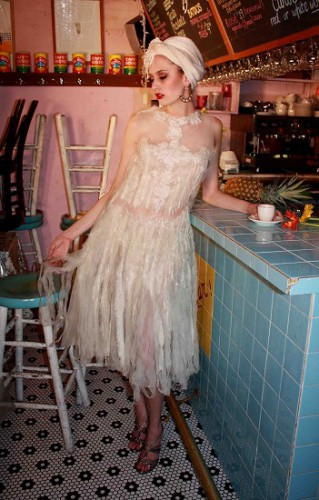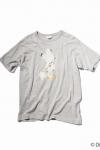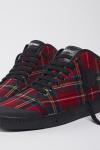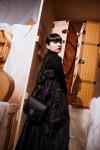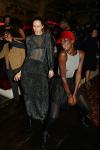“If there is something that you love and want to achieve, no one is going to hold your hand and open the doors for you”
-Can you explain short background of yourself and brand?
As a designer, painter and sculptor, being born in Cuba, the creative end of my mind triggered me at a very early age to design and craft, while being raised in a home where there was significant inspiration and appreciation for fine art. At age sixteen, I had showed my first collection of sassy and elegant dresses in my hometown, Miami for Fashion Week of the Americas. I have had the privilege to have interned for Marc Jacobs, Esteban Cortazar, Narciso Rodriguez.My luxury eveningwear line was opened in New York in 2007 and I sold my first collection to Ikram while still in my last year at Parsons The New School for Design.
-What do you think about benefit of using Japanese fabric?
I think Japanese fabrics are incredible. I have never seen fabrics as beautiful. I am so excited I have been given the opportunity to use and explore a different way of using textiles.
-What do you think about Japanese market and Japan fashion week?
I really admire the Japanese fashion industry for taking risks and allowing designers to really explore creativity in design. I think it shows forward thinking and assertiveness in the mindset of the Japanese. I really respect that.
-Can you explain about latest 10 S/S Collection
I titled my collection Orishas, which means deity in the Afro-Cuban religion of Santeria. The collection is made up of thirteen cocktail to evening wear looks, all hand-made, with a rich use of texture. With unique fabrication such as leather cording, rope, chiffon, raffia lace, organza, and attention to high craftsmanship, surface treatment, and details, I created this collection very much like a painting, using bits and pieces of fabric–like brushstroke–for the woman who views herself as a piece of art.
-Are you going to change anything to suit Japanese market?
I’m actually going to expand into more day-wear, adding pants and jackets, and knits. Also elongating the silhouettes and designing them to be airy and ethereal, avoiding being body conscious.
-Do you find Caribbean roots (Cuba) in your design?
Yes, I find that I do have an aesthetic that would appeal to Latin or Carribean women since I come from Cuba. Carribean women love color and movement in their clothing. And most importantly they want to look beautiful and sexy, but not vulgar. So I find that I use very vibrant colors in my designs and I make silhouettes that would suit a latin woman, but I do this subconsciously, its something that I cant help.
-What did you learn in Parsons? How was it influenced your design?
Parsons was like boot camp. It was the hardest thing I have done in my life, but it was also the most wonderful. I think one of the most important things I learned at Parsons was time efficiency and making good connections with people. There was so much work to do, project after project, most of the time simultaneously. And I learned to be organized with my time, since there was only so little of it. I learned that I needed to make good lasting connections with people. And I also learned that Parsons would not make or break my career. A lot of people get really focused on the importance of the school that they went to or go to, but where you study should not matter. If there is something that you love and want to achieve, no one is going to hold your hand and open the doors for you. You have to be the one to go for it, be proactive and make the best out of any situation, and create the outcome that you envision.
-Is there any designers or person that had a strong influence of your career?
My parents have definitely had a very positive influence in my career. Without them my company would not exist. My mother is a costume designer and an extreme and vital person in my team. A designer that I most admire is John Galliano–ever since I was very little. When I saw pictures of his beautiful and dream-like designs I knew I wanted to be a fashion designer.
-How did you come to establish the label?
Well the label is really young still. It’s only two years old. But I always knew that I wanted my own company one day. So I just decided to get really serious about it and dedicated myself to finding the right factories, textile vendors, and introduced myself to store buyers and presented the line to them.
-How did you get into fashion in the first place?
My mother is a costume designer, and my father worked as a television producer and cinematographer so i have always been in a creative environment since I was very little. I would always watch my mother draw and I wanted to do the same thing. I remember when i was six years old we were watching a John Galliano fashion show on television and, and I thought I wanted to do that one day. So then my parents put me into art school which I attended all my life, and then I auditioned to a really amazing high school for fashion design in Miami, Florida and that allowed me to gain the skills in sewing. In high school I had a really incredible fashion design professor, Rosemary Pringle, who really believed in me and she just let me fly. That led to my acceptance at Parsons, which led me to New York City, where I really saw fashion.
-Where do you get inspiration from?
Everywhere, but it comes to me effortlessly. Inspiration is like a mood. It depends on what I am being attracted to at the moment. Its wonderful and interesting because as a designer, you surprise yourself by liking a certain fabric or idea that you wouldnt have thought of before, but for some subconscious reason you are being attracted to it.
-Do you view fashion design as a means of expressing yourself?
Absolutely. It is how I express my emotions about a current mood I am in. If I am feeling somber, my designs will mimic that mood. If I am feeling euphoric, the clothes will also reflect that. Fashion can also be like armor. You can use it as a disguise–to cover up how you are really feeling. Let’s say I was in a vulnerable mood, and I was going to meet someone later that day. I would wear what would make me feel secure with myself. I think that’s one of the most exciting things about fashion. It’s so psychological. You can always tell someone’s mood by seeing what they are creating or wearing.
-What do you place the most emphasis on in fashion design?
Texture. It is really why i design. It is because I love to paint and sculpt. So I treat fabric as if it were going on a blank canvas.
-How would you describe your own personal style?
Elegant, feminine, artistic.
-What are the difficulties faced being a designer today?
Mass market. Stores like H&M, Forever 21, ZARA, have made the fashion industry reduce its quality and durability and made customers settle for knock-offs and bad quality.
-How do you see your brand developing over the next couple of years?
I see my brand developing in a steady manner with devoted clientelle. The goal is just to dress women so I just want to keep doing what Im doing. Anything positive that introduces itself is great.


